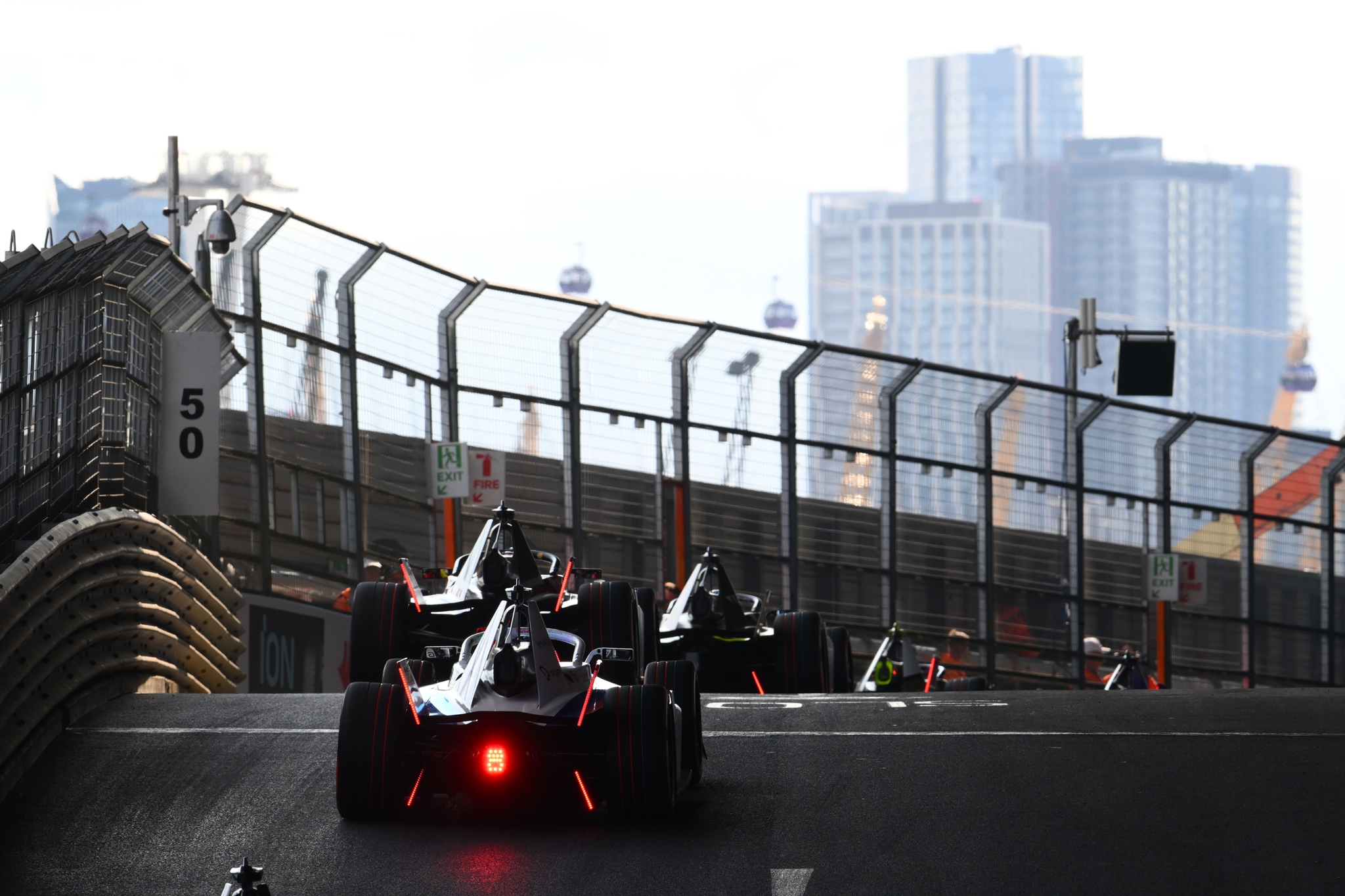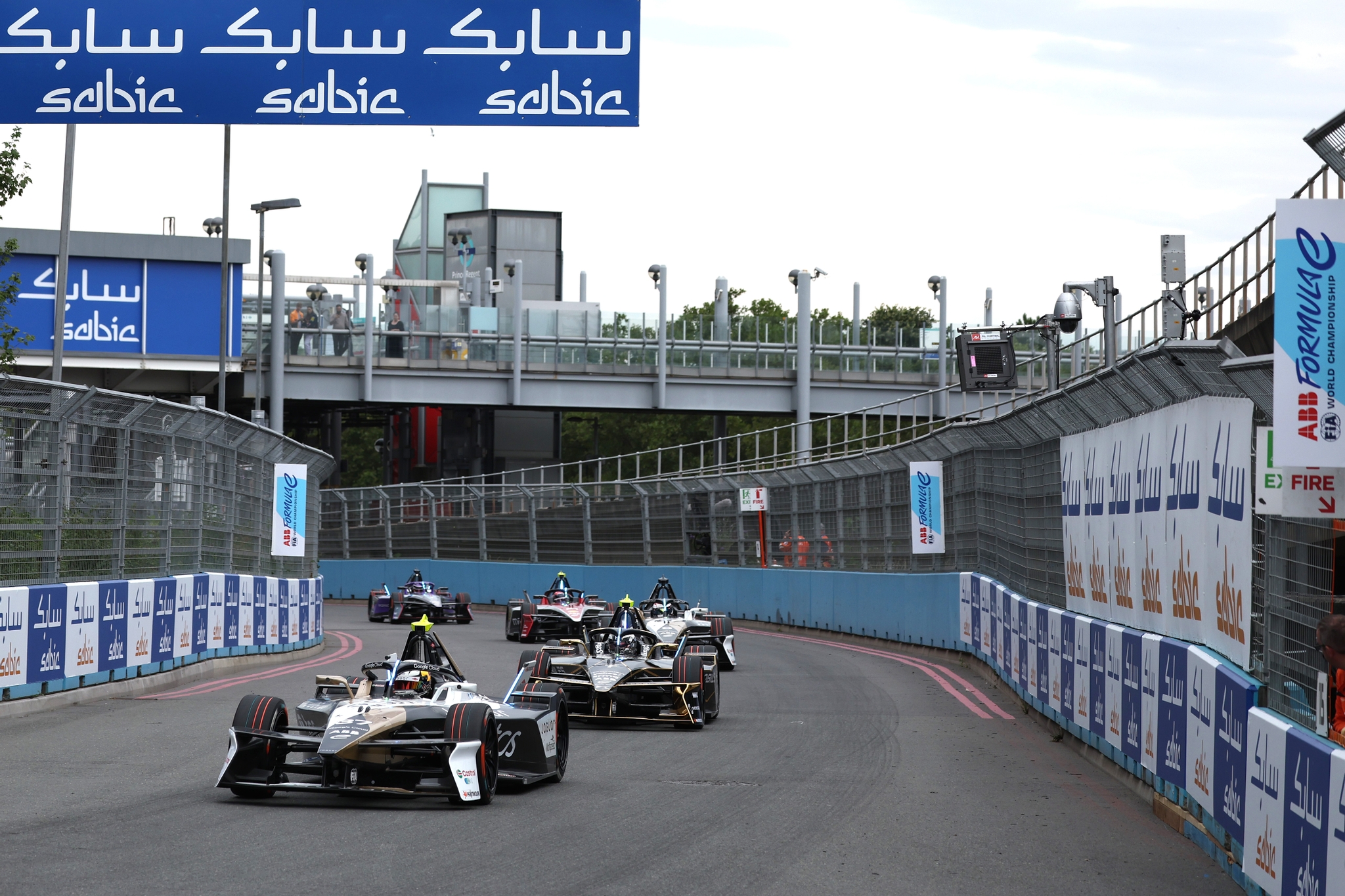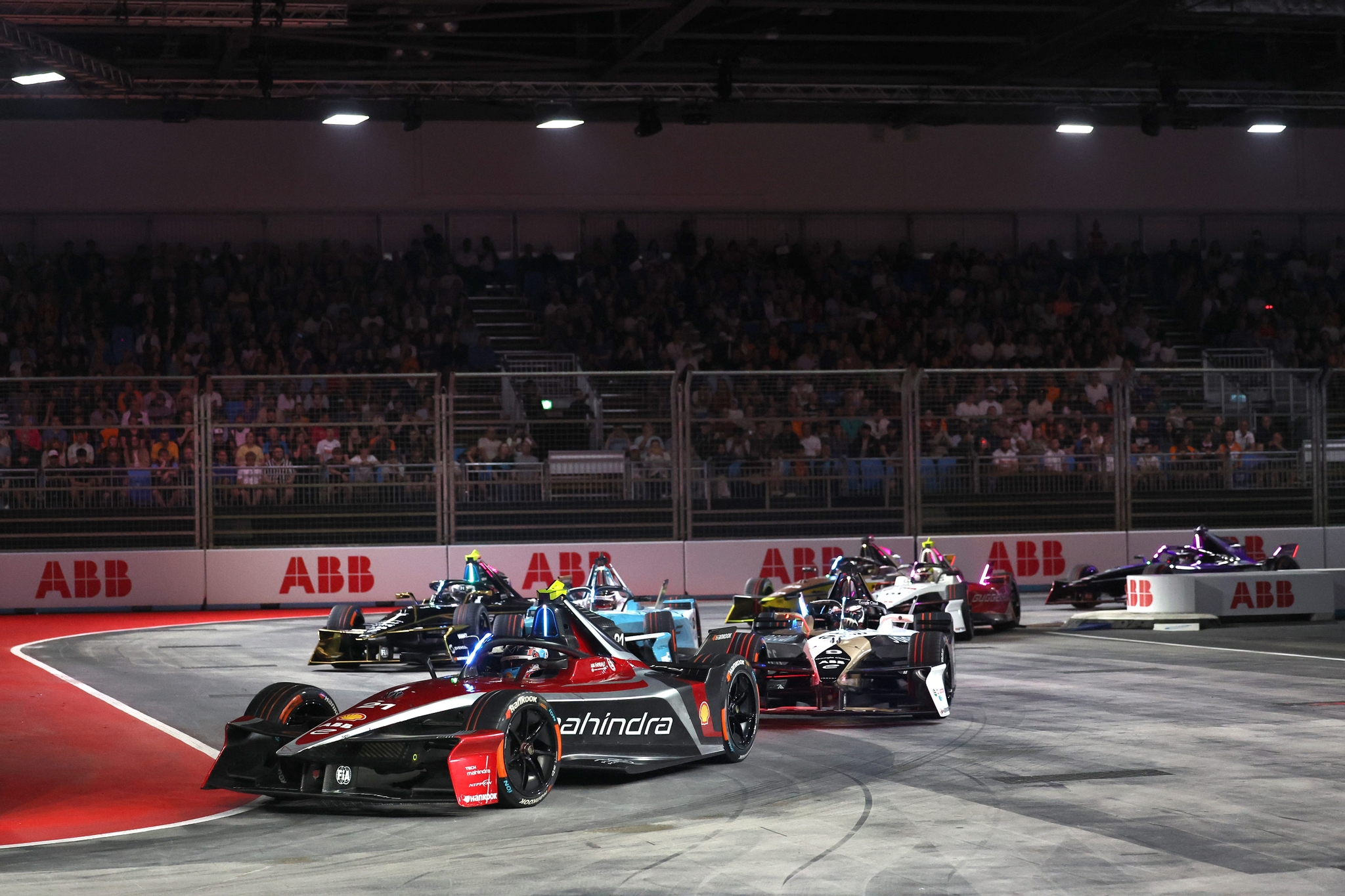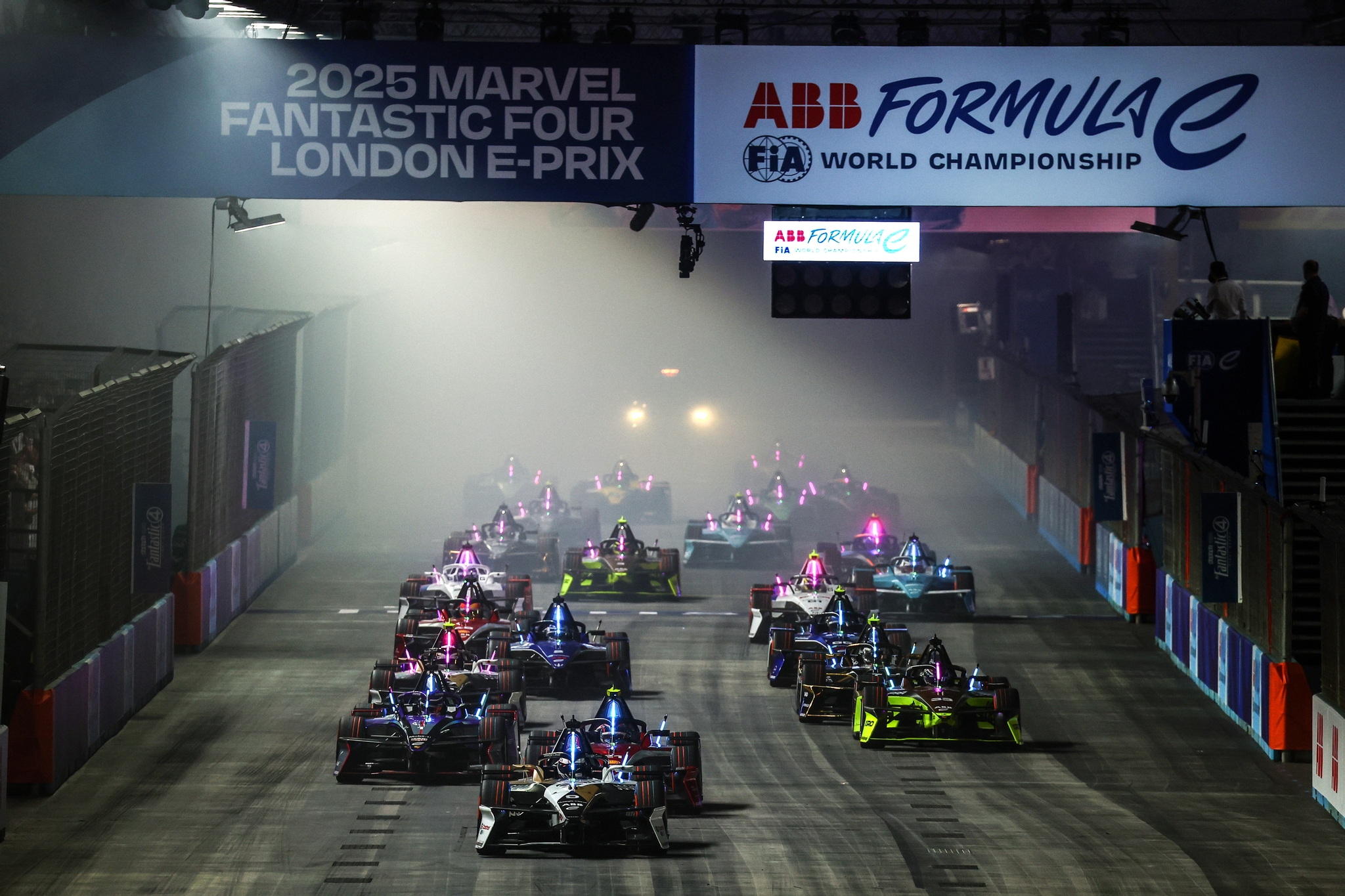We hope downforce doesn't ruin the racing when it arrives in a couple of years.
The haze is from drivers smoking their tires before the race start, for better purchase on the smooth indoor portion of the track. Credit: Joe Portlock/LAT Images
LONDON, ENGLAND—Formula E’s 11th season came to a close in its now-traditional London home this past weekend. In its first two seasons, it tried to make a go of racing in Battersea Park, a race that local residents rejected as too disruptive. After a five-year gap, the sport found a more receptive home at Excel London in the city’s Docklands, racing around and then through the cavernous exhibition center—something that’s only really possible with electric racing cars (or very fume-tolerant authorities).
As a location for an ePrix, Excel London is nigh-perfect. It’s fed by a pair of light rail stations just minutes from the center of town and comes preinstalled with concessions and restrooms and much of the other infrastructure that normally has to be brought in for a temporary circuit, with hotels literally walking distance. But like with most Formula E races, the few thousand fans in attendance, while not exactly an afterthought, aren’t really why the series shows up—this is a sport for an audience watching behind a screen.
It’s going to be the speed of the cars, rather than the size of the crowds, that causes Formula E to outgrow the 20-turn, 1.3-mile (2.09 km) circuit. Next year will be the final visit, before a possible Silverstone ePrix in 2027, once Gen 4 gets going.
No, they don’t swap cars anymore
If you’ve been following the sport since its inception, you’ll no doubt remember the initial Gen 1 car. Back in 2014, batteries cost more and stored less energy per unit of volume and mass, and the only way to get to the end of a 45-minute race was for each driver to have two identical cars, swapping at a mid-race pitstop.
Different drivers hop in and out of the same car in endurance racing, and in the old days a driver might have sometimes been replaced mid-race by a teammate if that looked like securing a better outcome. (As an aside, can you imagine the social media generation reacting to something like that? I’m not sure I even want to.) But drivers needing more than one car to finish a sprint race captured the public attention, and not in a good way.
Tell someone that you’re going to an ePrix and “is that the series where they change cars?” is more than likely the reply, even though car swaps went away with the arrival of the Gen 2 car in season 5.

Formula E has made a success of unique tracks; I hope it doesn't lose that as the cars get bigger and faster. Credit: Simon Galloway/LAT Images for Formula E
The current race car is known as the Gen 3 Evo, and it’s a far cry from the slightly underwhelming early days. Zero to 60 mph happens in less than two seconds, faster even than an F1. There’s part-time all-wheel drive with up to 470 hp (350 kW), and even before the introduction of the Evo package, the Gen 3 cars were hitting more than 170 mph (274 km/h) going into turn 1 at Portland.
But it’s all going to change again in just two years. When Season 13 starts in late 2026, Formula E enters its Gen 4 era. And it’s a huge technical upgrade. All-wheel drive becomes permanent, and the cars will have 804 hp (600 kW) to play with. But they’re growing in size, getting longer (by 20.4 inches/520 mm), wider (by 3.6 inches/97 mm), and with a 14.7-inch (375 mm) longer wheelbase, and a curb weight of just over a ton (1,016 kg). And Hankook tires will be swapped for Bridgestones, which are getting wider and softer.
"I think when we set up the objective of the Gen 4 car, thanks to technology improvement of electrical—mainly the cells, to be honest—definitely our focus was to show car performance," said Vincent Gaillardot, FIA technical director for Formula E.
In addition to being bigger and heavier, teams are also going to have high- and low-downforce configurations. Racing drivers will always want more grip, but the addition of aerodynamics to push cars down onto the track surface can fundamentally change the racing, and not always in a way that makes for an entertaining spectacle for the audience. That said, Formula E isn’t adding downforce to Gen 4 just because.
Change is never easy
"This was a hot topic. No mitigation: car performance, car performance, car performance. So this is why I went to 600 kilowatt. This is why the high grip tire, downforce and so on, because before, it was not possible. So we had to compromise other things to make the show and compromise performance. This time, no compromise at all," Gaillardot told Ars. Instead, Gen 4 will be a race car that doesn't have to apologize for not having an internal combustion engine.

The drivers love the challenge of the Excel circuit. Credit: Andrew Ferraro/LAT Images
"It's a must at the moment already, because we will get so powerful and quick," said Florian Modlinger, director of Porsche's factory Formula E program, which sealed both the team's and manufacturer's titles in London. "For the braking maneuvers, for the cornering speeds, some downforce is needed, and for me, it will be the biggest step in all the generations for car performance. How will this affect the racing? We are still investigating, because all our simulations are ongoing," he told me.
But aero is not about to become a new core competency for Formula E teams. The bodywork will be standard across all the teams, and a cost cap prevents anyone from trying to spend their way out of a problem.
"I have to always look back a bit to the last season, because in season 10, and in the last year, there was already the testing of Gen 3 Evo ongoing. We were in the championship fight in season 10, and we were already looking on the concepts of Gen 4. And under the cost cap, you need to allocate the resources to three parallel projects, you know: championship fight, Gen 3 Evo testing, and Gen 4 concepts," Modlinger said. Porsche took home the driver's championship last year to go with this year's pair of titles, so evidently the resource allocation worked quite well.
It sounds like we might see more room for technical development in the coming years. So far, the series has only allowed manufacturers freedom to develop things like motors, power electronics, transmissions, and software. Batteries, in particular, have been locked down to a single supplier to keep costs sane.
"We hope that, with Gen 4 being a game changer, that the return of investment of the series will improve. And for sure, as the FIA, and with the promoter and manufacturers, if really we have a good return on investment, we will open the perimeter to manufacture development of technology. This is really a balance we have to work with every single time," Gaillardot said.

Bums in seats are less important to the sport than eyeballs watching the race broadcasts. Four-hundred million is a much bigger number than 20,000, after all. Credit: Alastair Staley/LAT Images
"The clear standpoint is the series itself needs to be sustainable; sustainable for manufacturers and teams, and we need always to respect the cost cap, and we need to monitor how the series is growing. This means also the revenues are growing and the chances to increase them, then we can also think about [spending] more money," Modlinger said.
Spending controls and a rigid technical rulebook, rather than balance of performance, then, will be the plan.
"When you think what you could open additionally, you need to say that our powertrains are so efficient already—when you think about from the battery to the rear wheel, more than 97.5 percent. It's an impressive number. And there you maybe can think in the future if you should open up other things like battery infrastructure, battery cooling, battery thermal management, whatever little things where you can make a difference and which is relevant for the technology and for the road cars," Modlinger said.












 English (US) ·
English (US) ·